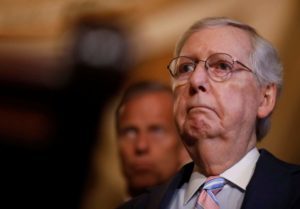After some back-and-forth over the past few weeks as to when some shuttered Connecticut businesses could start to reopen, Gov. Ned Lamont today affirmed that a number of sectors ”“ including restaurants, retailers and hair salons ”“ will begin to open on May 20.

“We’re just saying you have a green light if you want to,” Lamont said, noting that in states like Georgia and Oklahoma, not all businesses are opening despite their governors’ relaxing of restrictions. He further noted that some businesses would probably not be opening on May 20, in particularly in densely populated urban areas.
The list of businesses that can reopen on May 20 includes:
- Restaurants (outdoor service only; no bar areas)
- Remaining retail (including boutiques, jewelry stores, toy stores)
- Offices (workers should still work from home, if possible)
- Personal services (hair and nail salons only)
- Museums and zoos (outdoor only)
- Additional outdoor recreation (camping, mountain biking)
- University research programs
Lamont said the move is the first of a four-tier system, with a gradual lifting of restrictions continuing through the year. At least four weeks will pass between a move to the next tier.
Other factors going forward are a continued decrease in hospitalizations, adequate health care capacity and PPE, and appropriate physical distancing regulations. Reopen Connecticut Advisory Group Co-chair Dr. Albert Ko said that social distancing would continue to be observed through at least the summer.
Age restrictions ”“ such as asking 60-year-olds to remain home, and gradually raising that to 70 ”“ could be a part of the reopening strategy, as would restricting crowds to five to 10 and gradually increasing that.
Noting that Georgia and some other southern states that have already allowed businesses to reopen have as much as a four-week “head start on us,” Lamont said he was monitoring those situations closely.
He also pointed out that consumers are not necessarily rushing back to stores in those areas. “I think consumers will vote with their feet if they feel they’re opening too soon” in Connecticut, he said.
All of it is dependent upon an expected ramping up of testing and contact tracing, Lamont stressed. Should a sudden surge occur somewhere in the state, affecting hospital capacity and PPE, “we are going to recalibrate” the May 20 date, the governor said.
COVID-19 numbers
The state conducted another 2,315 COVID-19 tests, which yielded 933 more positive cases, bringing those respective totals to 97,133 and 27,700, respectively. Hospitalizations fell by 41 to 1,650 while deaths rose by 89 to 2,257.
In Fairfield County, another 309 positive cases were recorded, bringing that number to 11,294, while hospitalizations declined by 26 to bring that total to 565. Another 36 deaths brought that figure to 810.
Stamford still has the most positive COVID-19 cases in the state, with 2,390, followed by Bridgeport (1,961), New Haven (1,581), Norwalk (1,517), Danbury (1,372), Waterbury (1,298), Hartford (1,025), West Haven (726), Greenwich (668), Hamden (600) and Stratford (547).
The economic picture
Department of Economic and Community Development Commissioner David Lehman said earlier today that approval notices have begun to be sent out to businesses that applied for the DECD”™s $50 million emergency bridge loan program.
The DECD received over 5,000 applications within 48 hours of its March 26 launch, resulting in its shutting down. No further applications will be accepted.
At this afternoon’s briefing, Lamont shared some figures about how the state’s GDP is being affected by the pandemic. The state’s GDP stands at about $245 billion, he said, with $106 billion represented by businesses that have remained open by law, such as construction, manufacturing and essential retail. That sector accounts for about 11% of unemployment claims, he said.
Companies open but “closed” due to a lack of demand make up $38 billion and 29% of unemployment claims; businesses whose employees are working remotely ”“ primarily in the insurance, tech, and financial services sectors ”“ account for $77 billion and 12% of unemployment; and closed, non-operational businesses (bars, restaurants, salons, etc.) contribute about $25 billion but represent around 48% of unemployment claims.
Reopen Connecticut Advisory Group Co-chair Indra Nooyi said that it will probably take three to four weeks after May 20 to get a clear picture on how many people have returned to work, and how that figure will affect the unemployment numbers.
Advisory Group Webinar
Earlier this afternoon, a webinar featuring four members of the advisory group discussed the approaches being taken as the state gets ready to start reopening.
 “There aren”™t a lot of answers yet,” cautioned Connecticut Business and Industry Association (CBIA) President and CEO Joe Brennan, saying the event ”“ the first of several ”“ was designed primarily to solicit questions and concerns to be presented to the larger group.
“There aren”™t a lot of answers yet,” cautioned Connecticut Business and Industry Association (CBIA) President and CEO Joe Brennan, saying the event ”“ the first of several ”“ was designed primarily to solicit questions and concerns to be presented to the larger group.
Meetings of the 48-member group ”“ broadly divided into business and health care divisions, with numerous subcommittees focusing on various sectors ”“ have been “for the most part very collegial,” Brennan said, reflecting the fact that everyone is focused on reopening the state in a thoughtful, safe way.
“I think there”™s going to be a meeting of the minds” between the two divisions, he added, noting that each understands the challenges and concerns facing the other.
“All of our discussions have been focused on a statewide look at (business) sectors,” said Tim Phelan, president of the Connecticut Retail Merchants Association.
“We consider all our retailers to be essential,” he continued. “And we are also sending the message that retail is ready to reopen.”
How that reopening might look is still an open question, he acknowledged. If face-coverings are mandated for all employees and customers, “It will be extremely difficult for us to enforce that.” Nevertheless, he said, potential confrontations between staff and customers over the issue at stores that have remained open have been few.
 That some employees may be reluctant to return to work ”“ either due to health concerns or the “very good unemployment program right now” ”“ Garrett Sheehan, president and CEO of the Greater New Haven Chamber of Commerce, said is “definitely something we have to keep an eye on.” After all, he said, an economic recovery cannot take place without employees reporting to work.
That some employees may be reluctant to return to work ”“ either due to health concerns or the “very good unemployment program right now” ”“ Garrett Sheehan, president and CEO of the Greater New Haven Chamber of Commerce, said is “definitely something we have to keep an eye on.” After all, he said, an economic recovery cannot take place without employees reporting to work.
“I think people have been pleasantly surprised” by how smoothly the transition to work-from-home has gone, Sheehan said. He predicted that the trend would continue ”“ that a quickly organized Zoom conference call would be preferable than a 90-minute drive to attend in person ”“ though he added, “Being in-person still matters a lot.”
Meredith Reuben, CEO of EBP Supply Solutions in Milford ”“ which specializes in cleaning and disinfecting solutions ”“ said many office building operators have told her that they are reconfiguring their space to provide more distancing and protection for employees and clients, as opposed to the pre-pandemic trend toward grouping people into pods.
The specter of liability cases involving reopened businesses is also very real, Brennan said. “If employers are subject to lawsuits no matter what they do, they”™re darned if they do and darned if they don”™t,” he remarked. “There have to be some liability protections,” preferably established by Congress than by each state, he added.
“At the end of the day, it”™s not the businesses or the government or the hospitals who are going to make this work ”“ it”™s the people,” Brennan said.
D.C. GEARING UP FOR “CARES 2”
Speaker of the House Nancy Pelosi (D-California) said today that Democrats”™ next emergency relief bill could be in the neighborhood as the $2.2 trillion CARES Act, and that it will include nearly $1 trillion to help states and local governments that have been impacted by the pandemic.
 Known as CARES 2, the bill will likely also include hundreds of billions of dollars in further aid for workers, businesses and families.
Known as CARES 2, the bill will likely also include hundreds of billions of dollars in further aid for workers, businesses and families.
“We’re not going to be able to cover all of it, but to the extent that we can keep the states and localities sustainable, that’s our goal,” Pelosi said.
Senate Republicans are presumed to fight against the municipal and state aid component, having rejected that part of the interim COVID-19 relief bill passed last week.
Senate Majority Leader Mitch McConnell (R-Kentucky) said today on the Fox network that while he is amenable to possibly sending additional funds to the states, “We”™re not interested in borrowing money from future generations to send down to states to help them with bad decisions they made in the past unrelated to the coronavirus epidemic.”
Additional funding must be tied to liability reforms to prevent what McConnell predicted would be “an epidemic of lawsuits” against doctors, hospitals and businesses that are reopening in the current climate.
The numbers
As of this writing, there are more than 1.05 million positive cases and over 61,500 virus-related deaths in the U.S., with over 126,600 recovered. Globally, there are about 3.25 million positive cases and nearly 231,000 deaths, with more than 986,000 recovered.



















